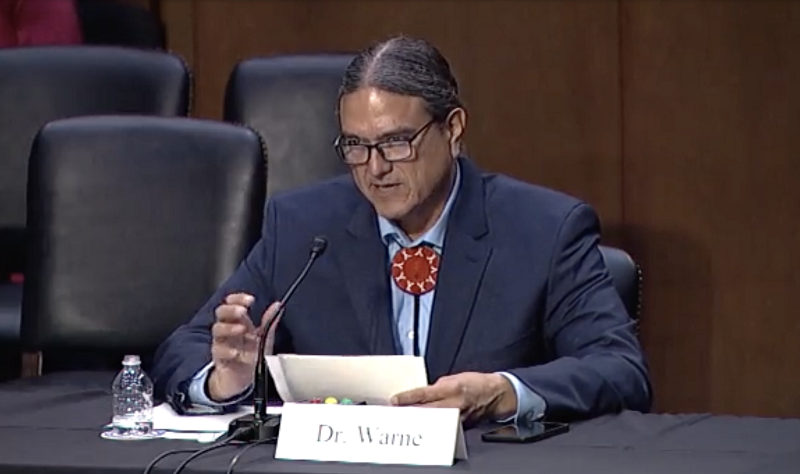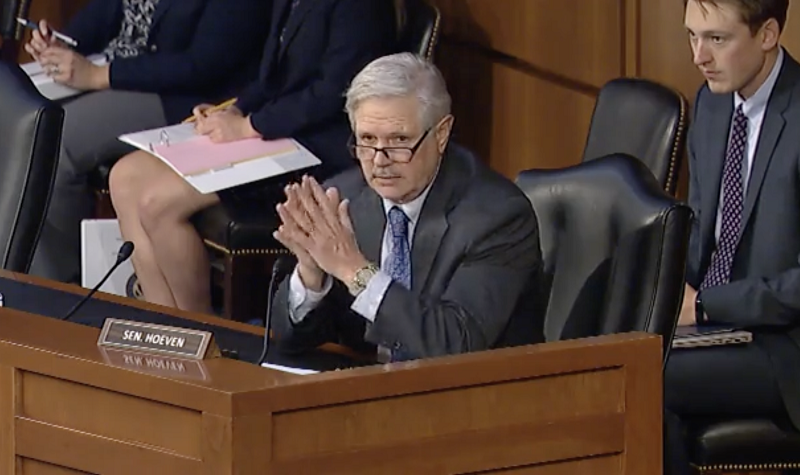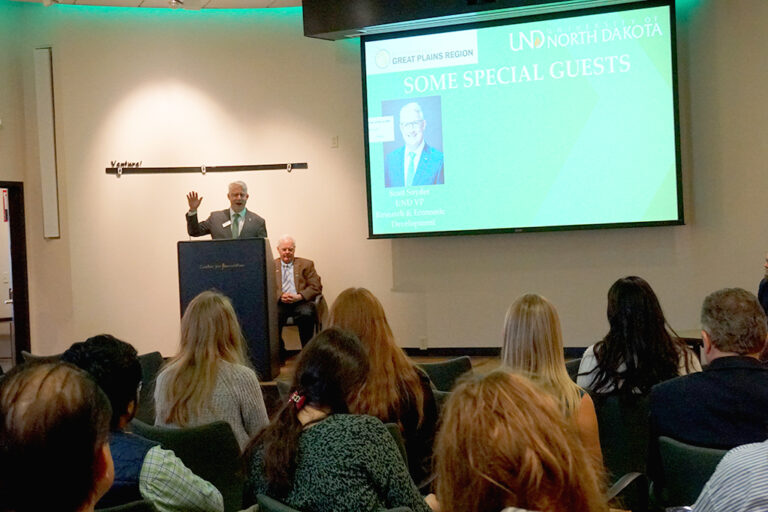UND researcher: American Indians’ health disparities often rooted in nutritional disparities
But evidence-based, tribally specific solutions can help address both disparities, Dr. Don Warne tells Senate subcommittee

The image shows a large container of syrup, with the label “USDA Food” prominently displayed.
And if you want to understand why tribal communities wrestle with such serious health problems – several of which are compounded by tribal members’ poor nutrition in childhood and infancy – you can start by reading further down on the commodity-food-product label.
That’s where you’ll find these instructions, just past the syrup’s ingredient list of Corn Syrup, Sugar Syrup and Flavoring:
“For use in baby formula,” the label reads.
Poverty plus loss of access to traditional foods on many American Indian reservations has brought about heavy reliance on federal commodity food programs, noted Dr. Donald Warne, associate dean of the UND School of Medicine & Health Sciences and professor of Family and Community Medicine, in the testimony he gave on Nov. 2 to a U.S. Senate subcommittee in Washington.
Though the nutritional value of such programs has improved in recent years, for decades the programs handed out foods such as lard, bleached flour, refined sugar and sugar-sweetened beverages.
The foods helped encourage diets that are high in calories but poor in nutritional value, Warne declared. Add factors such as reservation households lacking access to grocery stores, and you’ve got “key determinants that place the American Indian population at higher risk of obesity and its associated chronic disease outcomes.”
Sen. Hoeven: ‘Thank you for your leadership’
Warne testified at a hearing on “The State of Nutrition in America 2021.” The hearing, which was held before the food and nutrition subcommittee of the U.S. Senate agriculture committee, featured Warne and a panel of nutrition and food-policy experts from institutions such as Cornell University, Tufts University and Texas A&M.
“Dr. Warne is a member of the Ogala Lakota tribe,” said U.S. Sen. John Hoeven, R-N.D., to his fellow subcommittee members in introducing Warne.
“He also is director of the Public Health Program and the Indians into Medicine Program at the University of North Dakota medical school. And I just have to tell you, this is one of the most amazing programs in the country. It encourages Native Americans to enter the field of medicine – doctors, nurses, med techs, and everything else. … This is just a model of a fabulous program.”
“Thank you for your leadership of this incredible program,” Hoeven said to Warne.

Crises of disparities
In his remarks, Warne gave a brief version of his testimony and had his full version entered into the Senate record. The full version is available here, and Warne’s oral testimony begins at 38:52 on the video of the hearing, which is available here.
“We need to recognize that for American Indians, we have a crisis of nutritional disparities and subsequent health disparities,” Warne said in his remarks to the subcommittee.
“Less access to healthy foods and dependence on inexpensive processed foods leads to weight gain.”
As a result, he said, “obesity rates for American Indians and Alaska Natives are at a critical level. According to the CDC, 48 percent of the American Indian and Alaska Native population over the age of 18 is obese, compared to 30 percent of the non-Hispanic White population.”
Obesity is a significant risk factor for Type 2 diabetes and heart disease, two of the leading causes of death for Indigenous people in the United States, Warne continued. Partly as a result, American Indians and Alaska Natives still have the highest prevalence of Type 2 diabetes in the nation, and American Indian and Alaska Native adults are almost three times more likely than non-Hispanic White adults to be diagnosed with diabetes.
“In my personal experience, I served as a family physician at the Gila River Indian Reservation in Arizona for a number of years,” Warne continued. “This is a community with among the highest rates of Type 2 diabetes in the world. I’ve seen first-hand the challenges of managing diabetes in a population that has limited access to healthy food sources.”
Investing in healthy food
Moreover, Warne’s hometown of Kyle, S.D., which is on the Pine Ridge Indian Reservation, is 90 miles away from the nearest supermarket. “As a result, many of my family members contend with significant barriers to accessing healthy foods, and many of them are suffering from diabetes and heart disease,” he said.
“In many of our tribal communities, substantial expenditures are made to manage patients with diabetes, such as dialysis for kidney failure, coronary artery bypass surgical procedures for heart disease, and amputations for diabetic neuropathy.” Add to that list such services as the wheelchairs and ramp-access to homes that Medicare provides to people who’ve lost mobility due to amputations.
“Rather than the significant financial expenses and decreases in quality of life associated with addressing just the complications of diabetes and heart disease, would it not make more sense to invest in healthy food in the first place?” Warne asked.
The news gets worse, not better: “According to the North Dakota Department of Health, the average age of death in the decade between 2009 and 2019 for American Indians was 56.8 years. In contrast, the average age of death for the White popluation was just over 77 years, so there’s just tremendous disparities,” Warne said.
Not to be lost in all of this – and the focus of much research at UND’s new graduate programs in Indigenous Health – are the historical traumas such as the loss of ancestral land, food systems, culture, language, ceremonies and self-sufficiency. Researchers are doing their best to “understand the impact of the unique history and social factors contributing to nutritionally influenced health inequities among Indigenous peoples in the U.S.,” Warne wrote in the full version of his testimony.
Meeting the challenge
That focus also is driving the search for effective solutions – solutions that are culturally appropriate and supported by tribally specific evidence. Promising strategies include:
- Improving existing food programs;
- Promoting breast feeding and early childhood nutrition;
- Promoting food sovereignty and increasing access to traditional foods;
- Expanding locally cultivated foods; and
- Taxing unhealthy foods and subsidizing healthier options.
“I applaud the idea of having a Second White House Conference on Nutrition, to gather more community-based input regarding the potential solutions and action items,” Warne told the subcommittee.
“We also need an approach that’s well-coordinated, and we need to understand the nuances of engaging tribes in these areas.
“Finally, please know that I am deeply honored to be here,” he said.
“Addressing nutritional disparities is challenging and complex, and we will not be successful in promoting the health of Americans with a one-size-fits-all approach. It is important to include Indigenous voices and perspectives in these discussions, and I appreciate this opportunity to address each of you. Thank you.”



